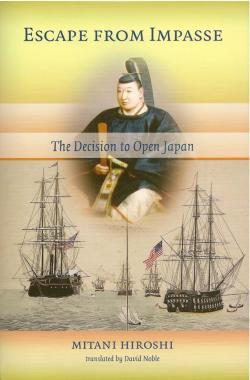Escape from Impasse: The Decision to Open Japan

I-House Press, 2006, 356 pages including notes and index, ISBN 978-4-903452-06-7, 3000 Yen
Review by Sir Hugh Cortazzi
This book is a valuable addition to the literature in English about the steps leading up to the treaties of 1858 which opened the way to the establishment of diplomatic and trade relations between Japan and the Western powers. It is also timely, as we celebrate this year the 150th anniversary of the Treaty of Yedo, concluded for Britain by Lord Elgin on 26 August 1858.
Professor Mitani’s work, like Professor McOmie’s The Opening of Japan, 1853-55, also published in 2006, concentrates more on the negotiations which prized open the door to Tokugawa Japan, than on the 1858 treaties, which unlike the earlier treaties focussed on trade and diplomatic relations.
Professor Mitani begins with a discussion of the foreign policy of the Tokugawa regime in the 17th and 18th centuries. He points out that the term sakoku (which may be roughly translated as “closed country”) dates from as late as 1801 when it was used in a translation into Japanese of an essay by Engelbert Kaempfer who had served as physician to the Dutch in Deshima in the late seventeenth century. “Consciously distancing Japan from the West seemed the most desirable way to maintain peace for Japan.” The concept of sonnō jōi (which may be translated as “revere the emperor and expel the barbarians”) became part of the philosophy of sakoku. In this context Mitani notes that Koga Tōan, a Confucian scholar, considered that Japan had no need any longer to fear the “diabolical religion” of the West as loyalty to the sovereign had become so deeply inculcated among the samurai and common people. Koga and some others like him even contemplated Japanese overseas expansion.
Mitani points out that the volume of Japan’s foreign trade in the eighteenth and early nineteenth centuries gradually sank, while interest in what was happening in the West grew. Matsudaira Sadanobu who became the dominant force in the Shogunate in 1787, for instance, “recognized no value in foreign trade other than the importation of books and medicines.” However the appearance of Russians around Ezo (now Hokkaido) made Japanese increasingly aware of the need for military preparedness in face of the potential foreign threat and of the increasing numbers of whaling vessels, many of them British, which resulted in the landing on Japanese soil of foreign sailors. These developments led to the issue of an order to repel foreign ships. But Bakufu officials, such as Mizuno Tadaakira, who became responsible for finance in 1818, wanted to reduce the burden on the daimyo of responsibility for Japan’s coastal defence and Japanese defences were accordingly neglected.
The Opium War of 1839-42, however, ensured that strengthening Japan’s defences became a major issue. Coastal defence surveys were made, but the costs were high and after leadership changes in 1843 the majority of the plans to strengthen coastal fortifications were abandoned.
Japan needed intelligence about western intentions and looked to the Dutch as a main source. But they rejected the Dutch advice to develop more flexible policies towards foreign ships. As Mitani comments (page 54): “Viewed in hindsight, the advice given by the Dutch was reasonable and honest. The subsequent forced opening of the country as a result of Perry’s military threat gave birth to a profound sense of national humiliation that became one of the fundamental factors in the collapse of Tokugawa authority.”
The Bakufu were divided between those argued for increased coastal defences in the interest of sakoku, even if it meant war with Western powers, and those who thought that Japan should give first priority to avoiding conflict. No consensus between these two views could be found.
In 1854 when a decision had to be made on a response to the American demands made by Commodore Perry the majority opinion within the Tokugawa government appears to have favoured rejecting the American demands, but in view of the inadequacy of Japan’s defences to try to delay any answer. The Bakufu undermined its own authority when in preparing for Perry’s return in 1854 they took the unprecedented action of informing all higher officials and all of the daimyo of the contents of the American letters and seeking consultations on them. Tokugawa Nariaki who led the hard line faction advocated a general proclamation mobilizing the nation for war while working for a peaceful resolution with the foreign powers. This stance came to be termed naisen gaiwa.
In the event the Japanese in 1854 were able to avoid any major confrontation because Perry’s primary concerns were, in Mitani’s view, to draw Japan into communication with the Western powers “and to ensure that the glory of that achievement should be enjoyed by the United States and himself.” To achieve this he was ready to give up the demands which he had made for the opening of commercial relations. Like the British Admiral Stirling at Nagasaki he was not really interested in trade.
The really difficult negotiations about opening Japanese ports to trade were those in 1858 with Townsend Harris, the American representative, over the US-Japan treaty of amity and commerce. The demand for the opening of the ports of Osaka and Hyogo was a particularly difficult one for the Japanese negotiators as they were so close to Kyoto, the ancient capital. Mitani asks why the Japanese negotiators, knowing the strong imperial opposition to such a concession which they had decided to make, “took the unprecedented step of appealing for imperial authorization of their actions?”

